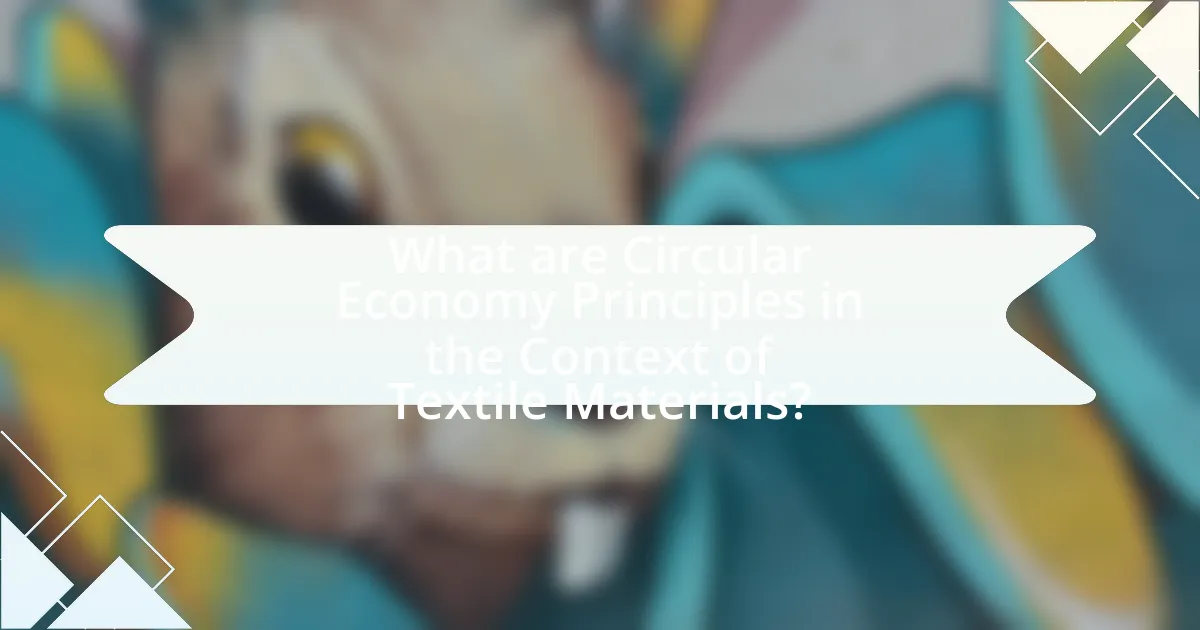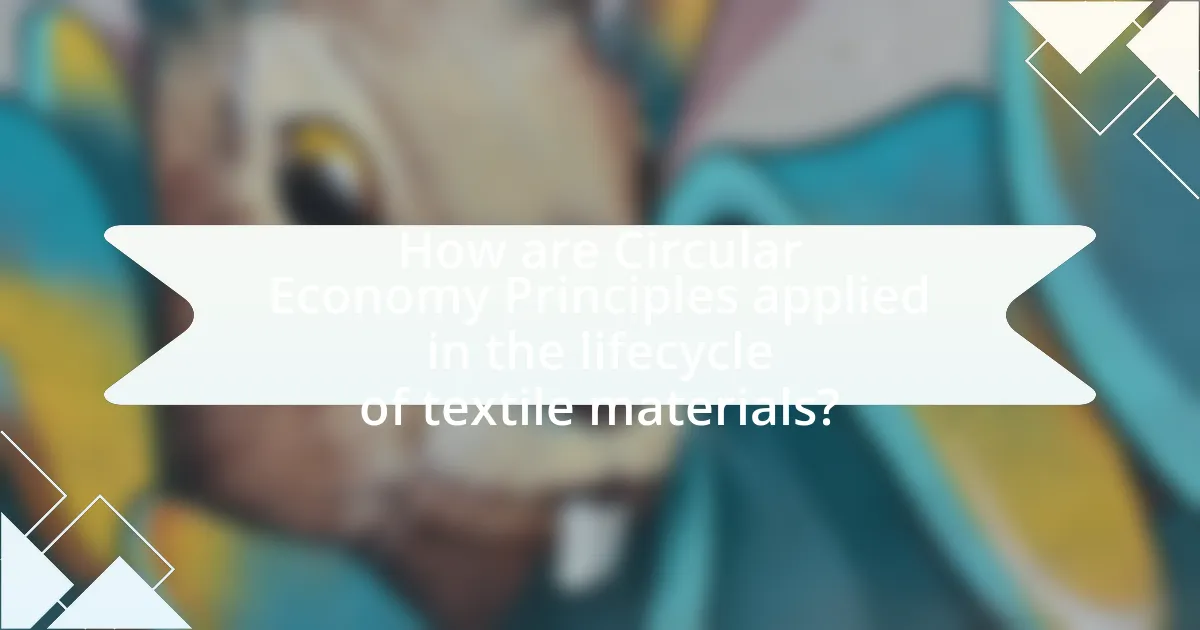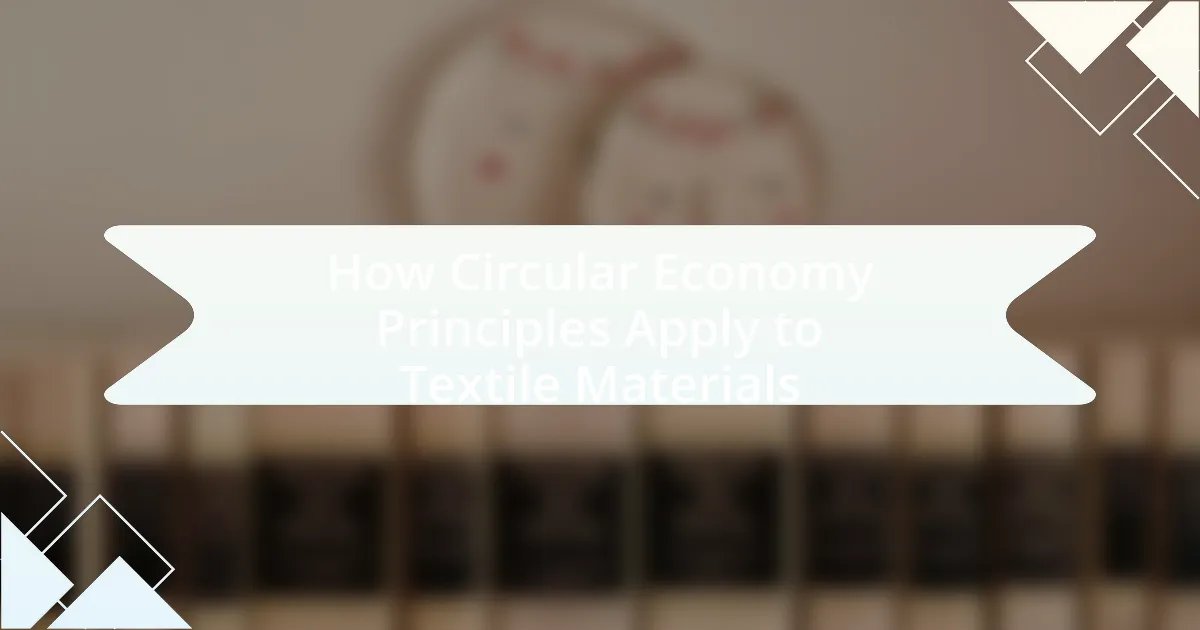The article focuses on the application of circular economy principles in the textile industry, emphasizing strategies that minimize waste and enhance resource efficiency throughout the lifecycle of textile materials. Key topics include the differences between circular and linear economic models, the importance of sustainable sourcing, and the benefits of designing for longevity and recyclability. It also addresses the challenges faced by manufacturers in implementing these principles, the role of consumer behavior, and successful examples of companies leading the way in circular textile practices. The article highlights the potential economic advantages and environmental benefits of transitioning to a circular economy in textiles, underscoring the need for collaboration and innovation within the industry.

What are Circular Economy Principles in the Context of Textile Materials?
Circular economy principles in the context of textile materials focus on minimizing waste and maximizing resource efficiency throughout the lifecycle of textiles. These principles include designing for longevity, promoting reuse and recycling, and utilizing sustainable materials. For instance, the Ellen MacArthur Foundation emphasizes that a circular economy in textiles can reduce environmental impact by encouraging the use of biodegradable fibers and closed-loop recycling systems, which can significantly decrease landfill waste and resource consumption.
How do Circular Economy Principles differ from traditional linear models?
Circular Economy Principles focus on resource regeneration and sustainability, while traditional linear models operate on a ‘take-make-dispose’ framework. In a circular economy, materials are reused, recycled, and repurposed, minimizing waste and environmental impact, as evidenced by the Ellen MacArthur Foundation’s research, which highlights that transitioning to a circular economy could reduce global carbon emissions by 39% by 2030. In contrast, linear models lead to resource depletion and increased waste, as they do not incorporate mechanisms for material recovery or sustainable practices.
What are the key characteristics of a circular economy?
A circular economy is characterized by its focus on resource efficiency, waste reduction, and the continual use of materials. This model emphasizes the importance of designing products for longevity, repairability, and recyclability, which contrasts with the traditional linear economy that follows a ‘take-make-dispose’ approach. In a circular economy, materials are kept in use for as long as possible through strategies such as recycling, remanufacturing, and sharing, thereby minimizing environmental impact and promoting sustainability. According to the Ellen MacArthur Foundation, transitioning to a circular economy could generate $4.5 trillion in economic benefits by 2030, highlighting its potential for both ecological and economic advantages.
Why is the textile industry a focus for circular economy initiatives?
The textile industry is a focus for circular economy initiatives because it is one of the largest contributors to global waste and pollution, with an estimated 92 million tons of textile waste generated annually. This sector’s significant environmental impact, including high water consumption and chemical usage, necessitates a shift towards sustainable practices. Circular economy initiatives aim to reduce waste by promoting recycling, reusing materials, and designing products for longevity, which can mitigate the industry’s ecological footprint and foster resource efficiency.
What are the main benefits of applying Circular Economy Principles to textile materials?
Applying Circular Economy Principles to textile materials primarily benefits sustainability by reducing waste and resource consumption. This approach promotes the reuse, recycling, and regeneration of materials, which can significantly lower the environmental impact of textile production. For instance, the Ellen MacArthur Foundation reports that transitioning to a circular economy in the fashion industry could reduce greenhouse gas emissions by 44% by 2030. Additionally, it fosters innovation in material design and production processes, leading to more durable and eco-friendly textiles. By implementing these principles, companies can also enhance their brand reputation and meet increasing consumer demand for sustainable products.
How does a circular economy reduce waste in the textile industry?
A circular economy reduces waste in the textile industry by promoting the reuse, recycling, and repurposing of materials, thereby minimizing the need for new resources. This model encourages manufacturers to design products with longer lifespans and easier recyclability, which leads to a significant decrease in textile waste. For instance, according to the Ellen MacArthur Foundation, transitioning to a circular economy in textiles could reduce global textile waste by 22 million tons annually by 2030. This approach not only conserves resources but also reduces environmental impact, as less waste ends up in landfills and fewer raw materials are extracted.
What economic advantages can businesses gain from adopting these principles?
Businesses can gain significant economic advantages from adopting circular economy principles in textile materials, including cost savings, increased resource efficiency, and enhanced brand reputation. By implementing practices such as recycling and reusing materials, companies can reduce raw material costs and minimize waste disposal expenses. For instance, a study by the Ellen MacArthur Foundation found that transitioning to a circular economy in the fashion industry could generate $560 billion in economic benefits by 2030 through reduced material costs and increased resource productivity. Additionally, businesses that embrace sustainability often attract environmentally conscious consumers, leading to increased sales and customer loyalty.
What challenges do textile manufacturers face in implementing Circular Economy Principles?
Textile manufacturers face significant challenges in implementing Circular Economy Principles, primarily due to the complexity of supply chains and the need for systemic change. The transition requires rethinking production processes, which often involves high initial costs for new technologies and materials. Additionally, manufacturers encounter difficulties in sourcing sustainable raw materials that meet quality standards while ensuring economic viability. The lack of infrastructure for recycling and waste management further complicates the implementation, as many textile products are not designed for disassembly or reuse. According to a report by the Ellen MacArthur Foundation, only 1% of textiles are recycled into new garments, highlighting the systemic barriers that hinder circularity in the industry.
What are the technological barriers to circular textile production?
The technological barriers to circular textile production include inadequate recycling technologies, limited material recovery processes, and insufficient data on material composition. Inadequate recycling technologies hinder the efficient breakdown of complex textile blends, making it challenging to recover high-quality fibers. Limited material recovery processes restrict the ability to reclaim valuable resources from discarded textiles, resulting in waste. Additionally, insufficient data on material composition complicates the sorting and recycling of textiles, as many garments contain mixed materials that are difficult to process. These barriers collectively impede the transition to a circular textile economy, where materials are reused and recycled effectively.
How do consumer behaviors impact the transition to a circular economy in textiles?
Consumer behaviors significantly influence the transition to a circular economy in textiles by driving demand for sustainable practices and products. When consumers prioritize eco-friendly materials, brands are compelled to adopt circular economy principles, such as recycling and upcycling, to meet these expectations. For instance, a survey by McKinsey & Company found that 67% of consumers consider sustainability when making a purchase, indicating a strong market preference for circular textile solutions. This shift in consumer preferences encourages companies to innovate in design and production processes, ultimately facilitating a more sustainable textile industry.

How are Circular Economy Principles applied in the lifecycle of textile materials?
Circular economy principles are applied in the lifecycle of textile materials through strategies such as sustainable sourcing, design for longevity, recycling, and waste reduction. Sustainable sourcing involves using renewable resources and materials that minimize environmental impact, such as organic cotton or recycled polyester. Design for longevity focuses on creating durable products that can withstand wear and tear, thereby extending their usable life. Recycling initiatives enable the recovery of textile materials at the end of their life cycle, allowing them to be repurposed into new products, which reduces waste. Additionally, waste reduction practices, such as minimizing production scraps and promoting take-back schemes, further support the circular economy by ensuring that materials are continuously cycled back into use rather than ending up in landfills. These practices collectively contribute to a more sustainable textile industry, aligning with the principles of a circular economy.
What stages of the textile lifecycle can benefit from circular economy practices?
The stages of the textile lifecycle that can benefit from circular economy practices include design, production, distribution, consumption, and end-of-life management. In the design phase, incorporating sustainable materials and modular designs can enhance recyclability. During production, reducing waste through efficient processes and using renewable energy can minimize environmental impact. In distribution, optimizing logistics and packaging can lower carbon footprints. The consumption stage can benefit from promoting sustainable usage and care practices among consumers. Finally, in end-of-life management, implementing recycling and upcycling initiatives can significantly reduce landfill waste and promote resource recovery. These practices collectively contribute to a more sustainable textile industry by minimizing resource consumption and waste generation.
How can design for longevity enhance the circularity of textile products?
Design for longevity enhances the circularity of textile products by creating items that are durable, repairable, and timeless, which extends their lifecycle and reduces waste. When textiles are designed to withstand wear and tear, they can be used longer, minimizing the frequency of disposal and the need for new resources. For instance, research indicates that extending the life of clothing by just nine months can reduce carbon, water, and waste footprints by 20-30%. This approach aligns with circular economy principles by promoting reuse and recycling, as longer-lasting products are more likely to be repaired or repurposed rather than discarded.
What role does recycling play in the circular economy of textiles?
Recycling is essential in the circular economy of textiles as it enables the recovery and reuse of materials, reducing waste and resource consumption. By recycling textile products, valuable fibers and materials can be reintroduced into the production cycle, minimizing the need for virgin resources. According to the Ellen MacArthur Foundation, recycling can significantly decrease the environmental impact of the textile industry, which is responsible for 10% of global carbon emissions. This process not only conserves natural resources but also helps in reducing landfill waste, as approximately 92 million tons of textile waste are generated annually worldwide. Thus, recycling plays a critical role in promoting sustainability and efficiency within the textile sector.
How can businesses integrate Circular Economy Principles into their operations?
Businesses can integrate Circular Economy Principles into their operations by adopting sustainable practices that prioritize resource efficiency, waste reduction, and product lifecycle management. This can be achieved through strategies such as designing products for longevity and recyclability, utilizing renewable materials, and implementing take-back schemes to recover and repurpose textile materials. For instance, companies like Patagonia have successfully adopted these principles by offering repair services and recycling programs, which not only reduce waste but also enhance brand loyalty and customer engagement. Additionally, research indicates that transitioning to a circular economy can lead to significant cost savings and reduced environmental impact, as evidenced by a report from the Ellen MacArthur Foundation, which highlights that circular practices could generate $4.5 trillion in economic benefits by 2030.
What strategies can textile companies adopt for sustainable sourcing?
Textile companies can adopt several strategies for sustainable sourcing, including the use of organic materials, implementing closed-loop systems, and establishing transparent supply chains. Utilizing organic materials reduces the reliance on harmful pesticides and fertilizers, which is supported by the Global Organic Textile Standard that certifies organic fibers. Closed-loop systems allow companies to recycle and reuse textile waste, minimizing resource consumption and waste generation; for instance, brands like Patagonia have successfully integrated this model. Additionally, transparent supply chains enable companies to trace the origins of their materials, ensuring ethical practices and sustainability, as highlighted by the Fashion Transparency Index, which assesses brands on their supply chain disclosure.
How can collaboration within the industry promote circular practices?
Collaboration within the industry can promote circular practices by enabling the sharing of resources, knowledge, and technologies among stakeholders. When companies work together, they can develop standardized processes for recycling and reusing materials, which enhances efficiency and reduces waste. For instance, initiatives like the Ellen MacArthur Foundation’s Circular Fibres Initiative demonstrate how partnerships between brands, manufacturers, and recyclers can lead to innovative solutions for textile waste management. This collaboration not only fosters a circular economy but also drives economic benefits, as companies can reduce costs associated with raw material procurement and waste disposal.

What are some successful examples of Circular Economy Principles in the textile industry?
Successful examples of Circular Economy Principles in the textile industry include brands like Patagonia, which utilizes recycled materials in its products and promotes repair and reuse through its Worn Wear program. Another example is the Dutch company MUD Jeans, which offers a leasing model for jeans, allowing customers to return them for recycling at the end of their life cycle. Additionally, the fashion brand Eileen Fisher has implemented a take-back program that encourages customers to return used garments for refurbishment and resale. These initiatives demonstrate effective applications of circular economy principles by reducing waste and extending the lifecycle of textile products.
Which companies are leading the way in circular textile practices?
Companies leading the way in circular textile practices include Patagonia, Stella McCartney, and H&M. Patagonia is recognized for its commitment to repairing and recycling garments, promoting a circular economy through initiatives like the Worn Wear program, which encourages customers to trade in used items. Stella McCartney emphasizes sustainable materials and has implemented a take-back program for recycling. H&M has launched its Garment Collecting initiative, allowing customers to return old clothes for recycling, aiming to use 100% recycled or sustainably sourced materials by 2030. These companies exemplify effective circular textile practices by integrating sustainability into their business models and actively engaging consumers in the recycling process.
What innovative materials are being used in circular textile production?
Innovative materials used in circular textile production include recycled polyester, organic cotton, and bio-based fibers such as Tencel and Piñatex. Recycled polyester, derived from post-consumer plastic bottles, reduces waste and conserves resources, while organic cotton is grown without harmful chemicals, promoting sustainability. Tencel, made from sustainably sourced wood pulp, and Piñatex, derived from pineapple leaf fibers, offer biodegradable alternatives to traditional textiles. These materials exemplify the principles of the circular economy by minimizing environmental impact and promoting resource efficiency in textile production.
How have these companies measured their success in implementing circular principles?
Companies have measured their success in implementing circular principles primarily through metrics such as waste reduction, resource efficiency, and product lifecycle assessments. For instance, brands like H&M and Patagonia track the percentage of recycled materials used in their products and the reduction in landfill waste resulting from their recycling programs. H&M reported that in 2020, 57% of its materials were sourced sustainably, demonstrating a commitment to circularity. Additionally, companies often utilize key performance indicators (KPIs) related to the circular economy, such as the number of products returned for recycling and the reduction in carbon emissions associated with production processes. These metrics provide concrete evidence of their progress towards circularity in textile materials.
What lessons can be learned from successful circular textile initiatives?
Successful circular textile initiatives demonstrate the importance of collaboration among stakeholders, innovation in material design, and consumer engagement. These initiatives often involve partnerships between brands, manufacturers, and recycling organizations, which enhance resource efficiency and reduce waste. For example, the Ellen MacArthur Foundation’s “Make Fashion Circular” initiative emphasizes the need for a systemic approach, showcasing how collaboration can lead to scalable solutions in textile recycling and reuse. Additionally, successful initiatives highlight the significance of designing for longevity and recyclability, as seen in brands like Patagonia, which focuses on durable products and repair services. Engaging consumers through education and incentives also proves vital, as demonstrated by H&M’s garment collection programs that encourage recycling. These lessons underscore that a holistic approach, integrating design, collaboration, and consumer participation, is essential for advancing circular economy principles in textiles.
How can smaller businesses adopt circular economy practices effectively?
Smaller businesses can adopt circular economy practices effectively by implementing strategies such as reducing waste, reusing materials, and recycling products. For instance, businesses can conduct a waste audit to identify materials that can be reused or recycled, thereby minimizing landfill contributions. According to a report by the Ellen MacArthur Foundation, transitioning to a circular economy could generate $4.5 trillion in economic benefits by 2030, highlighting the financial viability of these practices. Additionally, smaller businesses can collaborate with suppliers to source sustainable materials and design products for longevity, which aligns with circular economy principles.
What common pitfalls should companies avoid when transitioning to a circular model?
Companies should avoid underestimating the complexity of supply chain adjustments when transitioning to a circular model. This transition requires comprehensive changes in sourcing, production, and distribution processes, which can lead to operational disruptions if not managed effectively. For instance, a study by the Ellen MacArthur Foundation highlights that companies often fail to engage all stakeholders, including suppliers and customers, which is crucial for successful implementation. Additionally, neglecting to invest in technology for tracking materials can result in inefficiencies and waste, as accurate data is essential for optimizing resource use in a circular economy.
What practical steps can textile businesses take to embrace Circular Economy Principles?
Textile businesses can embrace Circular Economy Principles by implementing strategies such as designing for longevity, utilizing sustainable materials, and establishing take-back programs. Designing for longevity involves creating products that are durable and repairable, which reduces waste and extends the lifecycle of textiles. Utilizing sustainable materials, such as organic cotton or recycled polyester, minimizes environmental impact and resource depletion. Establishing take-back programs encourages consumers to return used textiles for recycling or repurposing, thereby closing the loop in the production cycle. According to the Ellen MacArthur Foundation, transitioning to a circular economy in textiles could reduce greenhouse gas emissions by 44% by 2030, highlighting the significant environmental benefits of these practical steps.

Leave a Reply